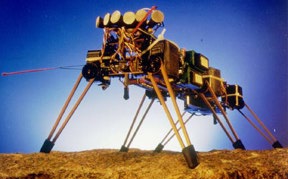Return to MODULE PAGE
Behavior-Based "Bottom-Up" Robots
Text Authors: Jeremy Gottlieb, Josh De Leeuw, Ken Livingston, and David Leech Anderson
Virtual Bottom-Up Lab: Hospital Task Created by: Josh De Leeuw
Virtual Bottom-Up Lab: Ethology Task: Ken Livingston & Josh De Leeuw
A new direction in robotic control has emerged which uses a "bottom-up" approach to robotic design. Also called, "behavior-based" robotics, these systems do not impose a high level of control or organization on the system and thus do not require complex computer programs to guide and control the robot's every move. Instead, a variety of simple "behaviors" are built into the robot's repertoire. These behaviors are layered and organized into a heirarchy, with more abstract goals farther up the heirarchy. The most common form of heirarchy is a subsumption architecture, so called because lower layers are subsumed by higher layers. In this architecture, what control exists is reflected in the fact that higher levels are allowed to inhibit or suppress the actions of behaviors in lower layers of the heirarchy. Robots built on this architecture may consist of nothing but a few "stupid" behaviors, but organized in the right way, it can produce very "intelligent" behavior. It has brought a revolution in the field of robotics.
Building Robots from the Bottom-Up
Behavior-based robotics is a style of robotics in which robots are programmed with many independent behaviors that are coupled together to produce coordinated action. The field developed in response to the shortcomings of traditional artificial intelligence (AI); robots were slow and had trouble operating in complex environments because robots had to plan out all of their actions based on internal world models. The mantra of behavior based robotics, written first by field founder Rodney Brooks, is  “the world is its own best model.” In other words, behavior based approaches don’t even attempt to produce an internal “representation” of the world. Instead the relevant information is in the world itself. A second pillar of the behavior based approach is that complex behaviors are often broken down into many individual behaviors. Rather than having one complicated behavior that completes a particular task, behavior based robots typically have many individual behaviors that, when organized together, will accomplish the task. This strategy leads to robots that gracefully degrade when they make an error; often the error only affects one of the individual behaviors, and the rest can proceed. Learn more about two of the pioneers in this field of robotics:
“the world is its own best model.” In other words, behavior based approaches don’t even attempt to produce an internal “representation” of the world. Instead the relevant information is in the world itself. A second pillar of the behavior based approach is that complex behaviors are often broken down into many individual behaviors. Rather than having one complicated behavior that completes a particular task, behavior based robots typically have many individual behaviors that, when organized together, will accomplish the task. This strategy leads to robots that gracefully degrade when they make an error; often the error only affects one of the individual behaviors, and the rest can proceed. Learn more about two of the pioneers in this field of robotics:
A. PIONEERS OF BEHAVIOR-BASED ROBOTS
Your next task is to learn about how behavior-based robots are employed in hospitals. There are currently hospitals that use robots as a kind of delivery truck -- to deliver medicines, surgical equipment, food, or anything else that needs to be moved from one location in a hospital to another. Watch these robots and consider how you might design them to function as they do.
B. BEHAVIOR-BASED ROBOTS IN HOSPITALS
It is now time to program a robot yourself. You will first observe the behavior of a complex robot and attempt to discover the correct "hierarchy" of behaviors that causes the robot to behave in the way it does. Then your job is to program that hierarchy into a robot and see if it behaves the way you predicted it would. Enjoy!
C. BEHAVIOR-BASED ROBOTICS LAB: The Ethology Task
Congratulations!! You have finished both of the behavior-based virtual labs and now you have completed all elements of The Mind Project's "Comprehensive Robotics Module" except for one final task where you will be asked to reflect upon the significance of what you have learned about robots. You will be asked to consider the question: Is the intelligence that human beings possess more "top-down" or "bottom-up"? Why do you think so. Let's consider . . .
You have now finished The Mind Project's "Behavior-Based" or "Bottom-Up" Robotics Module. If you haven't yet done our "Top-Down" Virtual Robotics lab, or have missed any of the rest our Comprehensive Robotics Curriculum, please check it out.D. AND WHAT ABOUT HUMAN INTELLIGENCE?




